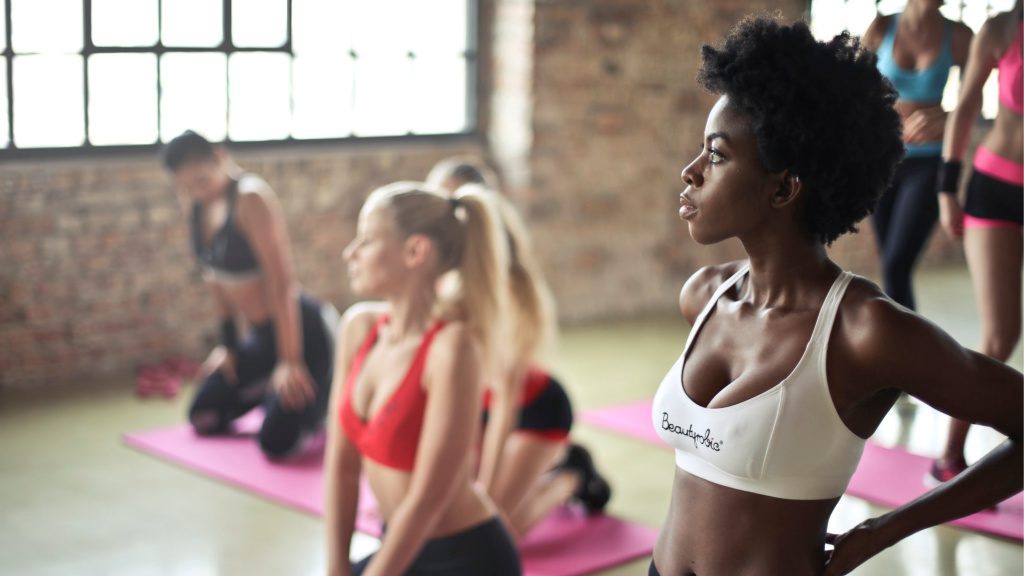Have you ever tried yoga? Are you a current yogi on the path to enlightenment? Yoga has been around for thousands of years. And in today’s health and fitness world, many hail Bikram Yoga as the ultimate in achieving mind/body balance and ultimate fitness.
If you have never tried yoga before, the thought of embarking on this type of adventure can seem quite daunting. Images of pretzel-like positions, incredibly fit and active people, and hour-long sweat sessions intimidate even the most ambitious. This article will offer you an overview of the benefits of yoga, as well as some of the specifics of Bikram Yoga.
Yogis repute that Bikram is the most effective for cleansing the mind, body, and spirit. So let’s answer this question first. What’s all this buzz about yoga?
What is yoga, anyway?
Yoga is an ancient practice of uniting the mind and body that has its roots in over 5000 years of East Indian philosophy. Physical postures, breathing techniques, and meditation are all symbiotically planned to give you, the yogi, the ultimate in mind/body balancing and physical fitness.
History of Yoga
No one can claim fame to the beginning or inception of yoga; men and women alike had engaged in the practice long before it became a documented, well-thought-out discipline. Yogis would pass along their knowledge and expertise to students, who taught their students, and the practice came to be what it is known as today.
The earliest accounts of an organized discipline are written in the “Yoga Sutra,” a manuscript penned over 2000 years ago. It is an account of how to completely master the mind, body, and emotions through the practice of specific postures combined with breathing techniques.
Believe it or not, the ancient practice of yoga did not hold physical fitness as its ultimate goal. The energy focused on reaching a state of spiritual enlightenment, mental and emotional peace. Starting in the Middle East, it gained popularity in the Americas at the beginning of the 19th century, where it has remained a steady and robust practice ever since.
Benefits of All Styles Yoga
There are several measurable benefits to beginning yoga practice. Some of these mind/body benefits include:
1. Decreased stress
Yoga is known to calm both mind and body, helping to reduce the adverse effects of stress. Regular practice of yoga has been known to decrease the production of cortisol in the body, which is a stress hormone that triggers other undesirable conditions that have adverse effects on your health.
2. Reduced anxiety
Yoga practice teaches the student to be in the present moment and focus on appreciation and gratitude for all that is. In creating these conditions and making it easier for you to tap into these “feel good” emotions, you’ll likely experience a greater sense of peace and well being.
3. Reduced inflammation
Yoga helps to stimulate the normal nervous system and immune system responses, which may help reduce excess inflammation and help safeguard you against the development of diseases like heart disease, diabetes, and cancer.
4. Improved heart health
Yoga does its part to improve circulation throughout the body, helping to keep arteries free from buildup. This results in lower cholesterol and lower blood pressure readings for those who regularly engage in the practice.
5. Improved quality of life
From greater flexibility to greater peace of mind, there are few disciplines that can boast as many whole body, whole brain benefits as yoga. With energy and vitality lasting well into your golden years, you are likely to experience a greater quality of life as you continue your practice.
 The Philosophy of Yoga
The Philosophy of Yoga
Yoga practitioners often use the imagery of a tree to convey a balance between the earth and the higher realms. Each branch of yogic service represents a branch on the tree.
Different types of yoga focus on certain aspects of existence:
- Hatha yoga–designed to prime the physical body and calm the mind
- Raja yoga–highly focused on brain evolution and meditation
- Karma yoga–the pathway of yoga that focuses on liberating one from karmic cycles and negativity
- Bhakti yoga–yoga that focuses on healing the emotions and focusing on greater humanity
- Jnana yoga–yoga that is designed to improve the intellect through study and meditation
- Tantra yoga–yoga that focuses on improving the body to enjoy ultimate pleasure in relationships
In recent years, there has been a focus on hatha yoga postures in an environment designed to cleanse and rejuvenate the body.
This type of yoga is known as Bikram yoga–yogis practice in a room that is heated to over 100 degrees in an effort to help the body detoxify, create conditions ideal for flexibility, and increase endurance. Students of Bikram yoga report that they experience significant mind/body benefits from the beginning of practice, and that it’s like no other discipline in terms of how dramatically it improves physical, mental, and emotional health. Let’s take a look at Bikram yoga and see what separates it from other types of yoga:
A Bikram Yoga Overview
Bikram yoga is a type of yoga developed by Yogi Bikram Choudhury; it involves a series of 26 poses and two breathing exercises performed in a room that is heated to 105 degrees. Sessions typically last about 90 minutes.
Benefits of Bikram Yoga
The Bikram style of yoga is known to promote deep relaxation and detoxification, and it improves flexibility and strength if performed correctly. Doing Bikram under the watchful eye of a trained instructor can help you to avoid some of the potentially dangerous complications that come with practicing rigorous postures in such a hot space. If you decide to take up Bikram yoga, tread carefully, drink a lot of water, and look forward to these changes in mind and body for lasting results:
1. You will experience greatly improved flexibility
Stretching while warm is much better for your muscles than cold stretching. The heat in a Bikram studio fosters greater flexibility and range of motion. Thus, the temperature allows you to deepen and get the full effect of each intended pose.
2. You will burn more calories
A 160-pound person burns about 200 calories per hour during a regular yoga session. Turning up the heat allows for maximum calorie burn. Recent studies show that this difference can be as much as 450 calories per session for men and 330 for women! An increase in heart rate, respiration, and improved circulation all contribute to this extra burn.
3. You will build more bone density
Supporting your weight during a yoga pose helps to build bone density. This is particularly important as we age; bone loss and bone brittleness increase the risk of injuries that can affect the quality of life. If practiced regularly, Bikram can help to reduce the development of osteoporosis and other age-related disorders.
4. You’ll reduce your stress level
You’ll be able to feel a marked improvement in relaxation and well-being following a Bikram yoga session. Yoga students are stronger, more confident, and ready to take on life’s challenges. This positive approach to tackling life results in more joy and less stress.
5. You’ll reduce symptoms of anxiety and depression
A study indicates that a regular Bikram yoga routine helps reduce anxiety and depression symptoms significantly. This became the standard way of handling depression and anxiety for the same study participants, many of whom were able to stop taking prescription medications for the same conditions.
6. You’ll strengthen your heart
You’ll not just strengthen your heart, but your lungs, muscles, and all other systems of the body. Hot yoga revs up your circulation, your respiration, and your metabolism, providing the same challenging workout effects as walking briskly at a pace of 4 miles per hour.
7. You’ll lower your blood glucose levels
Any type of exercise improves circulation and helps to stabilize blood glucose levels. However, Bikram hot yoga is known to produce dramatic results in regulating glucose, particularly in those who are at risk for or suffer from type 2 diabetes.
8. You’ll glow!
You will have a red, flushed appearance after your session. That’s because you’ll likely sweat more than you ever have before. On the other side of the shower, however, your skin will be glowing, as you’ve managed to push out harmful toxins and slough off dead skin cells during your session. You’ll look and feel better than you have in years.
Safety Tips When Starting Bikram Yoga
As with any exercise program, get your doctor’s approval before taking on a new exercise pursuit. Even if you are in good health, here are some things to keep in mind when practicing Bikram:
1. Stay hydrated
Drinking enough water before, during, and after a Bikram session is essential. Dehydration is a real concern, as you’ll be sweating throughout the class. So stay hydrated to reduce potentially life-threatening consequences of severe dehydration.
2. Be upfront about pre-existing health conditions
Some people faint in the high heat and humidity that accompany hot yoga. Those with high blood pressure, heart disease, diabetes, anorexia, and other autoimmune conditions should let their instructor know prior to class that they should be watched closely for signs of weakness and fainting.
3. Be mindful of low blood pressure and low blood sugar
If you periodically deal with low blood pressure or low blood sugar, you need to check with your doctor to determine whether Bikram yoga is safe for you. Check with your instructor to see if there are modifications that you can make in postures that will make practice more comfortable.
4. Pregnant? Proceed with caution
In general, it is not wise to take on a new exercise pursuit when pregnant, but something that you have been doing prior to getting pregnant is sometimes considered acceptable. Listen to your body, talk to your doctor, and proceed carefully for your sake and for baby’s sake.
5. Stop immediately if…
If you feel dizzy, faint, or weak, by all means, stop immediately and seek a quiet place where you can cool off and rest. Bikram yoga is an ambitious pursuit and one that should not be practiced lackadaisically.
Final Thoughts: Give Bikram Yoga a Try!
Bikram yoga is an exciting journey of transformation, but you need to consider both benefits and risks before attempting a class. Talk with area instructors, visit a class, and feel free to ask questions to determine whether Bikram is right for you. Namaste!




















